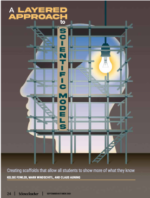• Explanatory Element Prompts • Table Tent • Poster • PPT of Explanatory Element Menu
This set of resources (described below) is adapted from an article in The Science Teacher, called A Layered Approach to Scientific Models: Creating Scaffolds that Allow All Students to Show More of What they Know. This piece appears in the September/October issue of 2020, pp. 24-36. The authors are: Kelsie Fowler, Mark Windschitl, & Claus Auning.
The beginning three paragraphs of text from this article sets the context for the resources:
Although there are many types of models used in science— graphs, equations, computer simulations, physical replicas, charts, etc.—pictorial models are unique in that they require students to create their own images to explain what is happening and why. Pictorial models have, at their core, a sketch that bears a resemblance to things or actions in the real world. These might be silhouettes of a human body fighting a bacterial infection, or a cutaway view of a car engine as combustion takes place. Teachers who are experimenting with modeling in their classrooms have students create initial, revised, and final versions over the course of a unit, and ask them to show what is observable and unobservable.
In this article, we outline a three-layer approach to designing model templates that support students’ efforts to draw and explain. We start with suggestions for how to phrase the essential questions students are responding to so that the purpose of their modeling is more focused and explicit. Then we explore different types of base pictorial layouts that become the foundational layer for the models. Finally, we provide a range of “explanatory elements” that teachers or students can integrate in their models to communicate a more robust explanation.
Importantly, we provide recommendations for how to scaffold the modeling experience so that students can eventually become more independent in selecting their own modeling tools or creating their own base pictorial layouts to show their unique thinking. The approach and model template examples we feature in this article are primarily used during students’ final modeling experience, not the initial modeling—a necessary distinction that clarifies the level of rigor expected in a final product and the amount of scaffolding provided by the teacher.
One set of resources below are prompts intended to be printable strips teachers can select while after circulating around table groups to help students individually identify explanatory elements that would help them show more of their thinking. Kelsie (the lead author) used an earlier version of these with high school students. For example, students were verbally explaining how a gene pool varied over generations but were struggling with the words to clarify their thinking. Kelsie gave the prompt for a “comic strip” to them and asked if they could draw what they think happened over time.
Another resource is a poster that can be put up in the classroom and referenced throughout the school year as students’ repertoire of modeling skills grows.
Another resource is a PPT slide that can be put into presentations and used as a visual when giving students directions about the expectations around modeling. The slide has a visual reminder of all of the elements but we can picture teachers narrowing the options down to 2-5 elements.
Table tents are the same idea as the PPT menu but designed for teachers who want something on students’ desk/tables that they can point to and reference.


 This site is primarily funded by the National Science Foundation (NSF) through Award #1907471 and #1315995
This site is primarily funded by the National Science Foundation (NSF) through Award #1907471 and #1315995